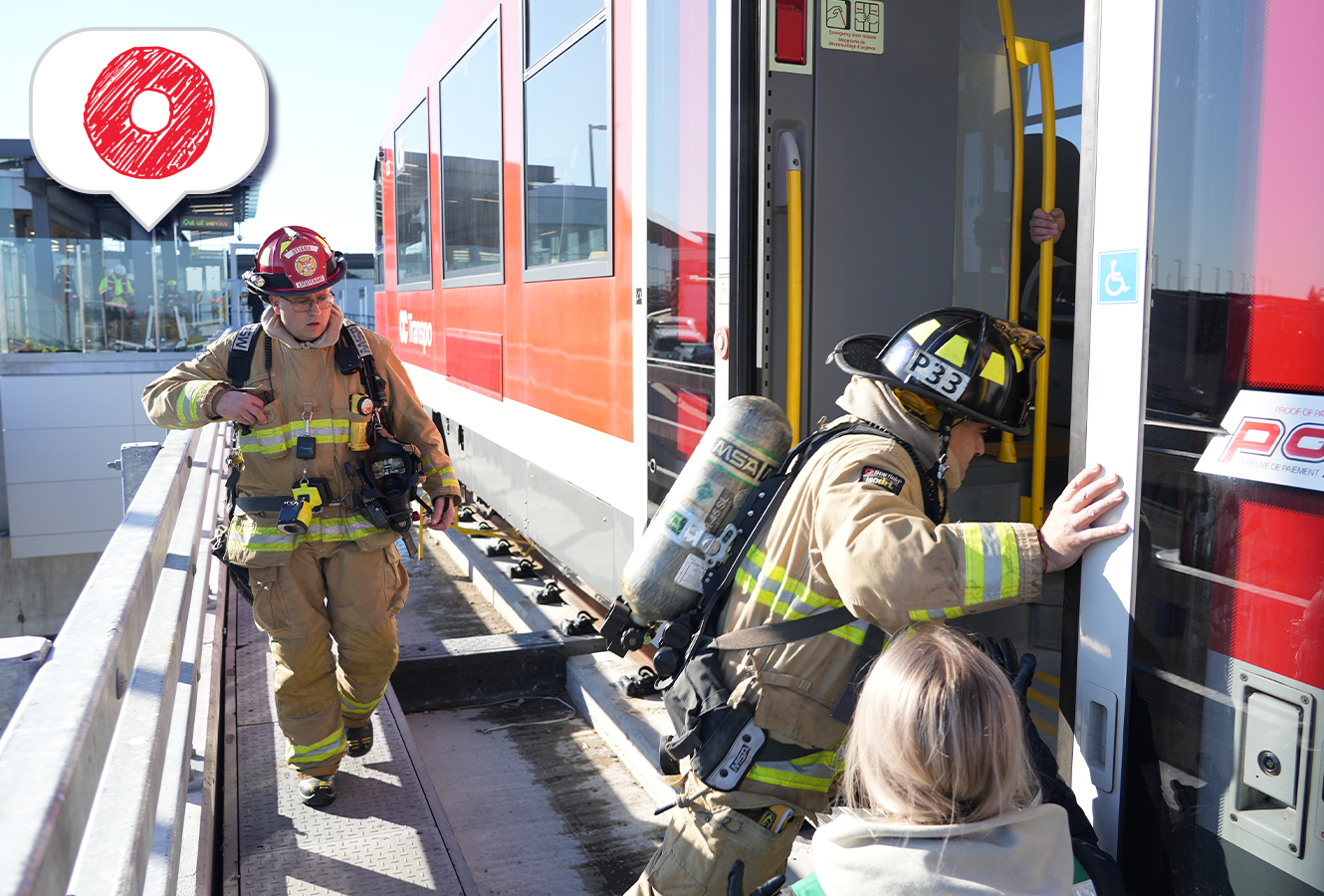Project Spotlight: Stage 2 Emergency Responder Training

We can’t say it enough. Safety is our top priority.
The O-Train System will soon allow you to take a train as far as Riverside South on Line 2 and to the Ottawa International Airport on Line 4.
On October 31, OC Transpo was joined by first responders at the airport for a unique training exercise to test emergency training, plans, and procedures. This was a critical milestone to ensure our team, City services and our partners are ready to safely operate the new system when it opens to the public.

Pictured above: Emergency vehicles are staged beside a stopped train outside of Airport Station during full scale exercise in October.
Click the image above for a closer look.
To find out more, we caught up with the Rail Construction Program’s Security Consultant, Peter, to learn about the training exercise and how it will help to ensure we are prepared for emergency situations leading up to the launch of Line 2 and Line 4.

Pictured above: Members of Ottawa Fire Services and Special Constables board a train during a drill at Airport Station.
Click the image above for a closer look.
Putting plans into practice
Emergency responder training has been progressively advancing in the lead up to launching Line 2 and 4. It includes in-class training, site visits, familiarization sessions, and table-top exercises. The culmination of all of this work was put to the test on October 31.
The full-scale exercise saw participants presented with a simulated fire emergency scenario. The goal was to test how they will respond given the procedures, plans and training that have been developed ahead of launching the system. Participants exercised their initial response to the scenario at the future Airport Station on Line 4.
This full-scale exercise was led by the Rail Construction Program and TransitNEXT, the constructor building the O-Train South extension. This exercise was conducted in cooperation with OC Transpo, the Ottawa Airport Authority, Ottawa Fire Services, Paramedics Service and Police Service. In addition, this unique training exercise was observed by members of the TTC (Toronto Transit Commission).
“This is a new venue to test our planned response. Not many cities get an opportunity like this. Allowing us to train in a transportation hub like the airport, we truly appreciate this rare situation,” says Peter.

Pictured above: Peter, Rail Construction Program’s Security Consultant
Click the image above for a closer look.
“The purpose of the full-scale exercise was to provide the chance for participating organizations and individuals to demonstrate and assess their preparedness for an emergency situation, while in a controlled environment. Through this exercise, they were able to determine strengths and identify areas for improvement to effectively respond to and recover from an emergency involving Line 4 at the Ottawa International Airport,” says Peter.
At OC Transpo, this drill involved everyone who would play a direct role in responding, including:
- Diesel Rail Operators
- Special Constables
- Rail Supervisors
- Transit Operations Control Centre
- Rail Superintendents
- Station Attendants
The exercise was overseen by evaluators who were observing in order to provide recommendations for how we can better improve our response to emergency incidents.
Peter says, “I was brought on for security, emergency preparedness and training as part of the Rail Activation team. It was truly a team effort with the Rail Activation Management Program (RAMP), TransitNext, OC Transpo, the Ottawa Airport and City Emergency Responders planning and working together to achieve this extensive exercise.”
The RAMP team has a wide umbrella that ensures the project is ready to launch. This drill was undertaken as part of the Security and Emergency Preparedness project. To find out more about the work being undertaken, you can watch this presentation.
“I’ve been on a lot of teams, this is a hardworking group and it’s a pleasure work with them,” said Peter.
Why do you do this?
“The Airport is a complex location that requires a great deal of interagency coordination,” says Peter.
When emergency responders answer a call, they need to know stations inside and out. This drill allowed them to practically test procedures that were taught during in-class training and familiarization tours.
“Conducting this exercise before Line 4 launches allowed for all parties to assess and validate OC Transpo, Airport Responders and First Responders activities, plans, policies, procedures, training, assumptions, and inter-agency agreements when responding to an emergency on O-Train Line 2 and 4,” said Peter.
Other key objectives included:
- Assess and identify areas for improvement specific to inter-agency and intra-agency coordination and communication.
- Assess OC Transpo procedures to enable safe access for Emergency Responders during an emergency.
- Identify gaps and areas for improvement in training, policies, procedures, communications, and other areas specific to emergency response on the Trillium Line.
- Improve individual and inter-agency response through practice.
- Strengthen individual and organizational preparedness and confidence in the ability to effectively respond to and recover from an emergency.
“This collaborative exercise has served as an excellent relationship building tool for our emergency service partners and in particular, the interface with another critical transportation hub. The Ottawa International Airport was instrumental in organizing and supporting this valuable exercise” says Peter.
What’s next?
After the drill, all organizations met to provide feedback in an open forum. All participants will be reviewing if the plans and procedures were effective given the feedback received to see if there any gaps in training and procedures and to highlight what went well.
Once all findings are gathered, emergency plans, procedures, and training will be updated to incorporate lessons learned.
Peter says, “This exercise truly proved the capability of Ottawa’s emergency responder and how they are prepared to deal with complex incidents . We can’t thank the Ottawa Airport Authority enough for hosting us and helping us facilitate this exercise. The level of cooperation was outstanding. We all benefited from their generosity.”
Further drills and familiarization tours with other stakeholders will continue as we prepare to the launch Line 2 and Line 4. To follow along on Stage 2 progress, visit the project website, signing up for the Stage 2 e-newsletter and follow OC Transpo on Instagram.
Let us know!
Did you enjoy this article? Do you have a story suggestion? Let us know by emailing thenextstopblog@ottawa.ca!

